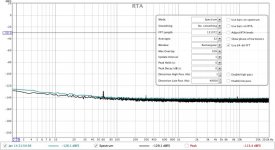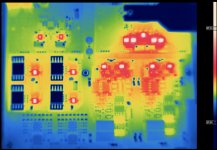The little board are arrived and I have installed them without any problem.
However after the installation I have noted a little worse the noise floor of the left channel.
This way I have installed a vertical opened shield between the right output and the left input and all returned ok, can be a little better than before the mod.
I have also reversed up-down the toroidal transformer and turned a little it exactly like done by another user, bettering so the residual noise at 50Hz. and 150Hz.
However after the installation I have noted a little worse the noise floor of the left channel.
This way I have installed a vertical opened shield between the right output and the left input and all returned ok, can be a little better than before the mod.
I have also reversed up-down the toroidal transformer and turned a little it exactly like done by another user, bettering so the residual noise at 50Hz. and 150Hz.
How was the test setup?
And what is the difference?
The little board are arrived and I have installed them without any problem.
However after the installation I have noted a little worse the noise floor of the left channel.
This way I have installed a vertical opened shield between the right output and the left input and all returned ok, can be a little better than before the mod.
I have also reversed up-down the toroidal transformer and turned a little it exactly like done by another user, bettering so the residual noise at 50Hz. and 150Hz.
I wouldn't expect any difference in noise. Do you have measurements showing the difference?
How was the test setup?
And what is the difference?
Loop back in the left channels looking at the noise @ 96KHz sample rate. 32 averaging rectangular window.
There is a little peak at 60Hz with the 3ft Tripp Lite USB cable not in the short USB cable.
Last edited:
The audio cable were the same, but since I do not have normal XLR cables on hand, I used two 65cm coaxial cables connected to XLR through converters. This did not change. I only swapped the USB cables. I will try tomorrow to see if it repeats.
Attenuators were 1V for both input and output. Cannot remember the FFT size, I will take note when I test tomorrow.
My main purpose at this time is to determine whatever measurements will show up different which might correlate with difference I hear on my system using the RTX6001.
The Y scaling seems confusing because it was dBFS, but when I saved it in REW, the range shifted to a different range.
Attenuators were 1V for both input and output. Cannot remember the FFT size, I will take note when I test tomorrow.
My main purpose at this time is to determine whatever measurements will show up different which might correlate with difference I hear on my system using the RTX6001.
The Y scaling seems confusing because it was dBFS, but when I saved it in REW, the range shifted to a different range.
Last edited:
I wouldn't expect any difference in noise. Do you have measurements showing the difference?
I am sorry, I was in hurry and not tought to save them, however was little difference; the left channel's noise floor was a little more dense of residual respect to before and with the little shield the two channels returned again pretty identical.
When I will open again it I will do with and without misurations ...
Jens a request for you: will be possible to have the pinout of the expansion socket for to build a spdif out board?
It should be easy and very useful for test DAC
And will be possible in some manner, when you do use this spdif out, don't have the RTX analog out active?
Thanks
How did you measure that? The noise floor seems to be very high!? And I can't see no difference between the two measurements.
The little peak at 60Hz is the difference, I cannot understand where the larger peak at 300Hz is coming from, but I will play around and find out. Noise level seem to be based on one scaling in REW which is at 87db I think. I am still trying to figure out what the scaling changed when I saved the RTA curve.
Is that repeatable?
There are typically small fluctuations in the readout. And hum at this level is easily affected by placement and other influences due to the environment.
How did you scale the y-axis?
Attenuator settings?
FFT size?
Audio cable?
Not repeatable today. The 60Hz harmonic is there on both cables. FFT length is 131072. Smaller FFT length seems to raise the noise floor, is this expected? Rectangular window seems to lower the noise floor a bit.

Smaller FFT length seems to raise the noise floor, is this expected?
Yes, this is expected.
Doubling the FFT length will reduce the noise floor by 3 dB. The total RMS noise is unaffected, but the noise is distributed over more bins, so every bin will contain a lower noise level.
The sound is amazingly clean and precise just using the unbalanced output. I wonder how it will work using fully balanced interface. The Tripp Lite cable seemed to give a lower noise level when running loop back harmonics tests in REW, so I decided to stick with this cable for now.
Not repeatable today. The 60Hz harmonic is there on both cables. FFT length is 131072. Smaller FFT length seems to raise the noise floor, is this expected? View attachment 656975
Yes, I'd expect everything to be like this.
The USB interface is galvanically isolated at the RTX, so it can't form a ground loop picking up hum.
Shorter FFT means wider frequency bins per FFT point, so each bin captures more noise.
DHL delivered a package to my door today.
Smaller bins same total noise, => less noise per bin. Greater number of averages and the smallest distortion spike looks huge.
Real world real time that tiny distortion spike is lost in a forest of noise.
The important noise figure we are not talking about is the 20K BW noise density. To some smaller degree small bin size and averaging will tend to fool us into thinking a apparently low noise floor is low noise, it is not.
Power line frequency / harmonics and IM products are what I do not like to see. Bin size and averaging do not help hide them. Real world real time they sound really bad.
DT
Smaller bins same total noise, => less noise per bin. Greater number of averages and the smallest distortion spike looks huge.
Real world real time that tiny distortion spike is lost in a forest of noise.
The important noise figure we are not talking about is the 20K BW noise density. To some smaller degree small bin size and averaging will tend to fool us into thinking a apparently low noise floor is low noise, it is not.
Power line frequency / harmonics and IM products are what I do not like to see. Bin size and averaging do not help hide them. Real world real time they sound really bad.
DT
The important noise figure we are not talking about is the 20K BW noise density.
It would be really good if this became a "standard" like using 50dB scale on loudspeaker measurements..
//
- Status
- Not open for further replies.
- Home
- Group Buys
- GB for RTX6001 Audio Analyzer with AK5394A and AK4490
